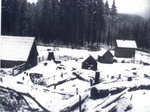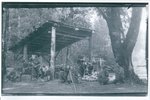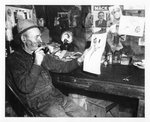




Newspapers from around the northwest carried the shocking news: Ole Peterson was severely burned while battling to save his burning home with buckets of water. His death followed two days later – May 6, 1953 – at Vancouver Memorial Hospital. His “stomping grounds” were in Skamania County, but he was better known to residents of Clark and Cowlitz counties. It was hard for them to imagine that the 85-year-old icon from the Lewis River valley was gone.
Most accounts indicate that Ole Peterson came to the Lewis River country in 1894 at age 26. He told folks he was born in Emmett County, Iowa, on October 3, 1867. Back in Iowa he owned what he referred to as a “stud farm.” Peterson often alluded to the Cleveland Panic of 1893 that caused him to lose the farm and maybe even a sweetheart. He claimed the Grover Cleveland presidency ruined the entire state of Iowa, so he left that dismal place and headed west. He would return there only once to attend his mother’s funeral.
For the last 20 years of Peterson’s life there were so many stories about him, either written or told, that he became a legend in his own time. He loved to spin yarns, but he was so full of jest it was difficult to separate fact from fiction. Was that big chunk gouged from his left ear the result of a cougar bite or a falling tree in a windstorm? Whatever the cause, the left ear is rarely seen in photographs. Although he talked big, Ole’s true height was closer to five feet, four inches. It could have been his whiskers, the mountain-man hat or the many layers of clothing that gave him a larger appearance.
Records indicate Ole had a brother living in Sumner, Washington, who may have had some influence on his move to the state. It’s more likely that someone had alerted him to the availability of homestead land in the upper Lewis River country.
The road leading east from Woodland was short before becoming a trail. It was only extended, as needed, to serve the growing settlements along the river and it would take years before a road reached Cougar Flats. Travel along the river pretty much followed the old Indian trail that eventually crossed over the Cascades. Peterson became friendly with the Indians still using the trail and credited them with saving him from starvation during his first winter in the area. Fishing for survival was not a part of an Iowan’s culture and the Indians tutored Ole in the primitive methods of catching wild salmon and steelhead in the river.
Accounts of his living quarters are unclear: Did he replace his first log cabin with a second one? However, when rough-sawed lumber became available he hired a man he referred to as “the engineer” to oversee construction of his permanent two-story home.
Land clearing was an ongoing task during the early years and Ole eventually had his own truck garden, orchard and bee colony. He was also known for canning. Over the years he became fairly self-sufficient but he still needed cash to buy clothing, staples, and to support his late-in-life appetite for store-bought whiskey. That habit may have been nurtured by the “busts” on his still by federal agents enforcing prohibition.
Peterson was particularly fond of both the Boy and Girl Scouts and welcomed them to camp on his land without charge. He was known for charging spelunkers for guided trips through a cave near his property or renting out equipment to those who wanted to explore it on their own. The cave, a lava tube about a mile and a half from his house that extends nearly 6,000 feet, eventually became known unofficially as “Ole’s Cave.”
Other sources of his income included prospecting, raising cattle and selling small stands of timber. The cattle ran loose but when the bulls roamed together they became quite aggressive toward neighbors and passers-by. In some cases, the only option people had was to shoot the bulls in self-defense and deal with Ole’s threats of legal action later. In 1944, a man shot and killed three bulls not far from the U.S. Forest Service guard station. Neither Ole nor the shooter would agree to dispose of the stinking carcasses, so the Forest Service had to pay a logger $25.20 to bury them with a Caterpillar.
Journalist and historian Ted Van Arsdol wrote about Ole Peterson in the 1964 edition of Clark County History. In that article, Peterson was described by an anonymous acquaintance this way: “Always an enigma, never an angel, self-contained, needing no social stimulus from without, a rugged individualist, a lover of nature, generous to a fault, though often rather gruff, a ready wit, a heart that was good, a liking for people, and above all at all times eccentric.”
Ken Teter, who owned and operated the Cougar store from 1947 to 1951, told Van Arsdol that the last note he received from Ole was dated April 18, 1953, 18 days before his death. It read: “dear friend Kenneth, The river is running low and my panter milk (whiskey) is allee drying up so I am sending another check for another shipment…don’t know when the upper dam (Swift) will go in yet the lower dam (Yale Reservoir) is nearly plugged? Lots of loggin.”
For his time, Ole Peterson might have been considered a well-read man, even if his English left a bit to be desired. He encouraged people to bring him the latest newspapers, books and magazines. In later years he received the newspapers and magazines by mail, but he became a hoarder, rarely throwing anything away — a trait that probably worked to his detriment when the house caught fire.
Politics were his primary focus and it wasn’t hard to know exactly where he stood. Discussing politics, he could seldom complete a sentence without swearing. He told people he had voted for FDR because he liked Teddy Roosevelt, but as the New Deal progressed he took to referring to the sitting president only as “Delano.” What sealed his attitude was FDR’s rationing programs during World War II; one thing you just can’t do to brewers and moonshiners is limit their supply of sugar.
Ole could always be counted on to stand by his staunch Republican beliefs. After selling his old Hupmobile to a Woodland resident in 1952, he promised he would ride in it again the following year for Woodland’s annual Planter’s Day Parade – but only if a Republican won the ’52 presidential election. It was not to be; even though Republican Dwight D. Eisenhower won the election, Ole died on May 6, 1953, before the planned parade. The next day the Lewis River News reported: “He kept his vow not to come out of his mountain retreat while the Democrats were in power.”
The great fire of 1902, known as the Yacolt Burn, came within three miles of Cougar and residents were thankful for the change in the weather that saved both life and property. Fire prevention fever slowly crept through the northwest as ranger stations and fire lookouts began popping up, including one atop Mount St. Helens. During the 1930s, the Civilian Conservation Corps established a camp near Peterson’s home and began building a series of trails, basket ferries and shelter camps. Some camps became ranger stations and access to the area began to open up.
Jerry McGee, author of the book Whiskey Riley, took a break while working on the Yale Dam project and visited Ole during the summer of 1951. McGee and a companion walked a good portion of the trail and were fascinated by some of Ole’s signs: “Give my regards to civilization, “This is my land -- Ole Peterson” and “No Damn Democrats allowed.” As Ole “entertained” McGee and his friend the conversation shifted to fine automobiles. Ole proudly showed them a Liberty touring car, a Chevrolet and the 1911 Hupmobile. McGee summed up his visit with this comment: “When we left, he shook hands with each of us with a grip that would shatter a diamond.”
Peterson’s financial and real estate dealings belied his reputation as a simple “mountain man.”
The Skamania County Auditor’s records indicate he was granted Homestead Certificate No. 5734, dated April 4, 1911. The conveyance, authorized by President Theodore Roosevelt, was for approximately 160 acres situated in Sections 29 and 30, Township 7N, Range 5E, of the Willamette Meridian. At the time of Peterson’s death, his land holdings were listed at 658 acres. The total acreage might have been even more had he not lost 180 acres through a Sheriff’s sale in 1920.
In 1925 Peterson borrowed $3,606.39 from Rufus Wagner, probably for a land purchase. Midway through the Great Depression, there was a Sheriff’s sale on Peterson’s home and property to remedy a delinquent note in favor of Wagner. On May 23, 1936, R. C. Sugg, attorney for the Wagner estate, became the legal owner of Peterson’s property. Later in the year, Sugg transferred his interest in the real estate to W. C. Studebaker.
Ole often claimed that in his entire life he had met only one honest lawyer (who just happened to be a Democrat). It’s probable that the lawyer was Vancouver’s D. Elwood Caples because Caples represented him in drafting a contract for sale, for the sum of $3,500, of all marketable timber on property he had lost in the Sheriff’s sale a year before – even though the property now belonged to Studebaker. Through a one-year right of redemption, Caples also negotiated return of the property to Peterson on June 7, 1937. Studebaker got his money back with interest and, presumably, everyone went away happy.
Other noteworthy recordings: for the sum of $100, Peterson sold a telephone and telegraph right-of-way to the United States Government (Forest Service) in 1918. For one dollar in 1934, Peterson granted a 40-foot road right-of-way to the Forest Service through section 29. When the road was finally completed many years later, it passed within 30 feet of his house. Friends remember a telephone hanging on Ole’s kitchen wall, so at some point he had limited service to the nearby ranger station. According to an unverified story, he jerked the telephone off the wall on learning that Republican Thomas Dewey had lost the 1948 Presidential election to incumbent Democrat Harry Truman.
Ole Peterson died without leaving a will. His niece, Nellie Thirion of Sumner, Washington, filed a Petition for Administration on May 20, 1953. Sixteen head of cattle and four calves were soon rounded up and sold to the Lewis River Meat Company for $1,498.
An Inventory and Appraisement document was filed July 20, 1954. On it, 658 acres were appraised at $3,500, or $5.32 per acre. In cash assets, there was $15,293 in a checking account at the Yacolt State Bank and $10,050 on deposit at Vancouver Federal Savings and Loan. Twenty-five hundred dollars in loans were owed to Peterson at the time of his death. The automobile and truck parts were listed as having a value of $25. Sixty years later, some people still find it strange that the Liberty and Chevrolet automobiles were not accounted for.
An order approving the Final Account and Decree of Distribution was filed on May 10, 1955. The liquid assets were divided among Peterson’s four surviving nieces and grand nieces. All of his real estate was granted to Nellie Thirion, who in turn sold to Pacific Power and Light (now PacifiCorp) on January 21, 1956. Judging from revenue stamps affixed to the deed of record, it appears the selling price was just over $7.00 per acre.
Thousands of people travel the NF-90 road every year between Cougar and Eagle Cliff. Long-time residents are aware that Ole lived in the Cougar Flats area, but with all of the changes to the landscape it’s difficult to figure out exactly where.
As part of the Swift Creek Dam construction project in 1956-58, a power canal was built that extends nearly three miles to the west, above and parallel to the former river channel. Today, the NF-90 road bridge crosses the power canal roughly half-way between the dam and the Swift No. 2 plant, at the east end of Yale Reservoir. The power canal, Swift No. 2 plant and the road south of the canal belong to Cowlitz Public Utility District. The land and road north of the canal belong to PacifiCorp.
Al Robbins was a timber cruiser and a well-known “man of the mountains.” Almost everyone in his family was close to Ole Peterson and visited him routinely. Ole, who was known as a pretty decent photographer, allowed Al Robbins, as well as others, to have pictures made from his glass-plate collection. Some of Peterson’s photographs have appeared in publications over the years but the glass plates, his trusty typewriter and a vintage violin were among his treasures lost in the house fire.
Robbins’ son, Quentin, still lives on their family home site near Ariel and volunteered to join me in a search for Peterson’s home site. Both landowners now prefer to have an employee accompany anyone wanting to access their property, and PacifiCorp allows the public open access to most of their land only by appointment. Our first trip proved to be inconclusive, but with additional maps, photographs and good fortune, the second inspection went well. A surveyor working along the canal pointed out the hub for the west line of section 29, which we had been unable to find.
A short distance east of the section line Quentin located the tiny creek where Ole built what he called his cider house. With the creek running beneath the house, it provided refrigeration for perishables and adult beverages during the summer months. The lower section of the creek was re-routed into a culvert during the construction process and can be seen along the north bank of the canal. There are no traces left of the orchard that was located immediately east of the creek.
The surveyor provided us later with engineer’s drawings used for construction of the canal. The drawings show the creek, the old road and the ranger station situated near where the southern bridge approach is today. The drawings were laid over an aerial photograph taken before any excavation was done in the area. The distance between the mouth of the creek and Ole’s home site appears to be about 100 feet. That being the case, the southern embankment of the power canal apparently was built directly over the spot where the home once stood.
The lower portion of the creek was eliminated during construction and now drains through a culvert along the north bank of the canal.
About the author
Gene Ritter, whose family arrived in Clark County in 1905, spent more than 40 years in the real estate and appraisal business. Gene’s Clark County historical writings have been published in volumes of the Clark County History book, as well as The Reflector, on multiple occasions. His wife, Janet Durgan Ritter, has family roots in Clark County dating back to 1853. The Ritters make their home on Whipple Creek.
At the fishing pier immediately north of the NF-90 road bridge there is now a historical marker (seen in this photo with Ritter) dedicated to Ole Peterson, featuring photos and a summary of his life.
Ritter gives Special thanks to contributors Erin Thoeny, Leonard Reese, Quentin Robbins, Ken Doane and surveyor Bill Pfleeger.